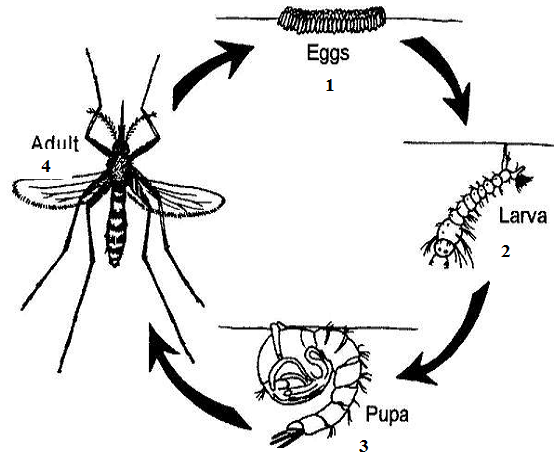Mosquito species including those of Anopheles carry out effective breeding and survival in freshwaters (i.e. waters with low salinity) than in salt waters (i.e. waters with high salinity). If the water in which the mosquito lays its eggs has high salt concentration (too saline), the larva and pupa stage of the mosquito cannot survive and produce the adult mosquito because the high salinity will dehydrate water from their body.
The female Anopheles mosquito has a high taste for blood which they either get from humans or animals (e.g. cattle, goat). Those that feed on human blood are said to be anthropophilic (anthropophily) in their nutrition while those that suck the blood of animals are said to be zoophily in their feeding habit.
Anopheles funestus and Anopheles gambiae are usually the two (2) species of female Anopheles mosquito that play significant roles in malaria transmission across the globe. Mosquito undergoes four stages in their life cycle; and these stages are shown below:
- Egg stage: This is the first stage in the mosquito life cycle.An adult mosquito can lay up to 200 eggs. The eggs are usually laid singly on stagnant water. The eggs have air sacs that allow them to float singly on the water. The eggs are laid in either freshwaters of blackish waters, and the eggs are susceptible to drying. After a few days (usually 2-3 days), the eggs hatch into thin larva that are known as wrigglers (Figure 1).
- Larva stage: The larval stage is the second phase in the mosquito life cycle. This stage follows the hatching of mosquito eggs (Figure 1). The larva is fitted with developed head that has antenna, mouth brushes for feeding, a thorax, spiracle for breathing and a segmented abdomen.

The mosquito is usually positioned horizontally to the surface of the water in order to breathe through its spiracles (breathing tube). The wrigglers (larva) are very active and swim in the waters. The mouth brushes allow them to sweep food particles (e.g. algae, diatoms and bacteria) into their mouth from the water surfaces. After about 2-14 days, the wrigglers develop into pupa.
- Pupa stage: The pupa stage is the third phase in the life cycle of mosquito (1). Mosquito pupae are usually comma shaped, and the pupa can also be called tumbler. They differ from the wriggler in that they do not feed.
A pupa has a head and thorax that are fused to form a cephalothorax. Pupae have breathing trumpets that allow them to breathe as they come to the surface of the water. The pupa burst open dorsally after a short time (usually 3 days) to release the adult mosquito (imago).
- Adult stage: The imago (adult mosquito) after emergence rests in the pupa case from which it emerged in order to dry its wings before flying away. The new adult mosquito if female, when matured and fertilized sucks blood from man in its environment. But if it is a male mosquito, it goes on to feed on sugary substances (nectar) from plants in its environment.
The chances of survival of the female mosquito are dependent on its ability to obtain blood meal, its ability to avoid host defenses, humidity and temperature. But in nature, a female mosquito does not last longer than 1-2 weeks. Most Anopheles mosquitoes are either nocturnal (i.e. they are active at night) or crepuscular (i.e. they are active at dawn or evening time).
References
Aschengrau A and Seage G.R (2013). Essentials of Epidemiology in Public Health. Third edition. Jones and Bartleh Learning,
Beers M.H., Porter R.S., Jones T.V., Kaplan J.L and Berkwits M (2006). The Merck Manual of Diagnosis and Therapy. Eighteenth edition. Merck & Co., Inc, USA.
Chiodini P.L., Moody A.H., Manser D.W (2001). Atlas of medical helminthology and protozoology. 4th ed. Edinburgh: Churchill Livingstone.
Dictionary of Microbiology and Molecular Biology, 3rd Edition. Paul Singleton and Diana Sainsbury. 2006, John Wiley & Sons Ltd. Canada.
Ghosh S (2013). Paniker’s Textbook of Medical Parasitology. Seventh edition. Jaypee Brothers Medical Publishers,
Gillespie S.H and Pearson R.D (2001). Principles and Practice of Clinical Parasitology. John Wiley and Sons Ltd. West Sussex, England.
Gordis L (2013). Epidemiology. Fifth edition. Saunders Publishers, USA.
John D and Petri W.A Jr (2013). Markell and Voge’s Medical Parasitology. Ninth edition.
Kumar V, Abbas A.K, Fausto N and Aster A (2009). Robbins and Cotran Pathologic Basis of Disease. 8th edition. W.B. Saunders Co, USA.
Lee JW (2005). Public health is a social issue. Lancet. 365:1005-6.
Leventhal R and Cheadle R.F (2013). Medical Parasitology. Fifth edition. F.A. Davis Publishers,
Lucas A.O and Gilles H.M (2003). Short Textbook of Public Health Medicine for the tropics. Fourth edition. Hodder Arnold Publication, UK.
MacMahon B., Trichopoulos D (1996). Epidemiology Principles and Methods. 2nd ed. Boston, MA: Little, Brown and Company. USA.
Mandell G.L., Bennett J.E and Dolin R (2000). Principles and practice of infectious diseases, 5th edition. New York: Churchill Livingstone.
Molyneux, D.H., D.R. Hopkins, and N. Zagaria (2004) Disease eradication, elimination and control: the need for accurate and consistent usage. Trends Parasitol, 20(8):347-51.
Nelson K.E and Williams C (2013). Infectious Disease Epidemiology: Theory and Practice. Third edition. Jones and Bartleh Learning
Roberts L, Janovy J (Jr) and Nadler S (2012). Foundations of Parasitology. Ninth edition. McGraw-Hill Publishers, USA.
Schneider M.J (2011). Introduction to Public Health. Third edition. Jones and Bartlett Publishers, Sudbury, Massachusetts, USA.
Discover more from Microbiology Class
Subscribe to get the latest posts sent to your email.




